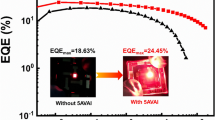Abstract
A novel Schiff-base-boron-quinacridone compound (4) has been synthesized. The absorption and emission properties of 4 have been studied carefully. Experimental results demonstrated that the introduction of Schiff-base-boron moieties could suppress the aggregation of molecules 4 in solution and enhance the photoluminescent efficiency in relatively high concentration solution. The energy transfer from the Schiff-base-boron moieties to quinacridone cores could take place in 4 system.
Similar content being viewed by others
References
Hiramoto M, Kawase S, Yokoyama M. Photoinduced hole injection multiplication in p-type quinacridone pigment films. Jpn J Appl Phys, 1996, 35: L349–L351
Shichiri T, Suezaki M, Inoue T. Three-layer organic solar cell. Chem Lett, 1992, 21(9): 1717–1720
Nakahara H, Kitahara K, Nishi H, et al. Orientation control of quinacridone derivatives with long alkyl chains in Langmuir-Blodgett films. Chem Lett, 1992, 21(5): 711–714
Nakahara H, Fukuda K, Ikeda M, et al. Langmuir-Blodgett films of polyheterocyclic compounds with long alkyl chains. Thin Solid Films, 1992, 210–211(2): 555–558
Shi J, Tang C W. Doped organic electroluminescent devices with im proved stability. Appl Phys Lett, 1997, 70(13): 1665–1667
Shaheen S E, Kippelen B, Peyghambarian N, et al. Energy and charge transfer in organic light-emitting diodes: a soluble quinacridone study. J Appl Phys, 1999, 85: 7939–7945
Aziz H, Popovic Z D, Hu N X. Organic light emitting devices with enhanced operational stability at elevated temperatures. Appl Phys Lett, 2002, 81(2): 370–372
Gross E M, Anderson J D, Slaterbeck A F, et al. Electrogenerated chemiluminescence from derivatives of aluminum quinolate and quinacridones: Cross-reactions with triarylamines lead to singlet emission through triplet-triplet annihilation pathways. J Am Chem Soc, 2000, 122(20): 4972–4979
Keller U, Müllen K, De Feyter S, et al. Hydrogen-bonding and phase-forming behavior of a soluble quinacridone. Adv Mater, 1996, 8(6): 490–496
De Feyter S, Gesquière A, De Schryver F C, et al. Aggregation properties of soluble quinacridones in two and three dimensions. Chem Mater, 2002, 14(3): 989–997
Potts G D, Jones W, Bullock J F, et al. The crystal structure of quinacridone: An archetypal pigment. Chem Commun, 1994, 2565–2566
Qiu D, Ye K, Wang Y, et al. In situ scanning tunneling microscopic investigation of the two-dimensional ordering of different alkyl chain-substituted quinacridone derivatives at highly oriented pyrolytic graphite/solution interface. Langmuir, 2003, 19(3): 678–681
Mu Z, Wang Z, Zhang X, et al. Two-dimensional supramolecular assemblies of quinacridone derivatives: from achiral to chiral racemates and domains. J Phys Chem B, 2004, 108(52): 19955–19959
Yang X, Mu Z, Wang Z, et al. STM Study on quinacridone derivative assemblies: modulation of the two-dimensional structure by coadsorption with dicarboxylic acids. Langmuir, 2005, 21(16): 7225–7229
Ye K, Wang J, Sun H, et al. Supramolecular structures and assembly and luminescent properties of quinacridone derivatives. J Phys Chem B, 2004, 109(16): 8008–8016
Wang W, Han J J, Wang L Q, et al. Dynamic π-π stacked molecular assemblies emit from green to red colors. Nano Lett, 2003, 3(4): 455–458
Lewis F D, Wu T, Burch E L, et al. Hybrid oligonucleotides containing stilbene units excimer fluorescence and photodimerization. J Am Chem Soc, 1995, 117(34): 8785–8792
Liang K, Farahat M S, Perlstein J, et al. Exciton interactions in nonconjugated squaraine dimers. Mechanisms for coupling and consequences for photophysics and photochemistry. J Am Chem Soc, 1997, 119(4): 830–831
Author information
Authors and Affiliations
Corresponding author
Additional information
Supported by the National Natural Science Foundation of China (Grant Nos. 50773027 and 50520130316), the Major State Basic Research and Development Program (Grant No. 2002CB613401), Jilin Province Science Foundation (Grant No. 20050120) and the Program for Changjiang Scholars and Innovative Research Team in University (Grant No. IRT0422)
About this article
Cite this article
DingYi, Y., YunFeng, Z., JingYing, Z. et al. Synthesis and luminescent properties of a Schiff-base-boron-quinacridone compound. Chin. Sci. Bull. 53, 1651–1656 (2008). https://doi.org/10.1007/s11434-008-0240-6
Received:
Accepted:
Published:
Issue Date:
DOI: https://doi.org/10.1007/s11434-008-0240-6




